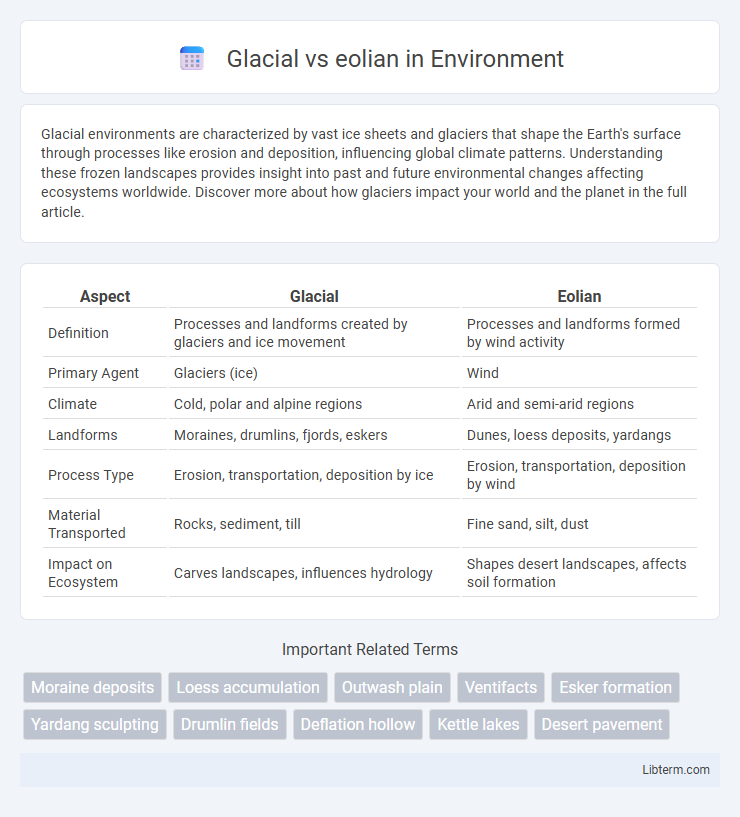Glacial environments are characterized by vast ice sheets and glaciers that shape the Earth's surface through processes like erosion and deposition, influencing global climate patterns. Understanding these frozen landscapes provides insight into past and future environmental changes affecting ecosystems worldwide. Discover more about how glaciers impact your world and the planet in the full article.
Table of Comparison
| Aspect | Glacial | Eolian |
|---|---|---|
| Definition | Processes and landforms created by glaciers and ice movement | Processes and landforms formed by wind activity |
| Primary Agent | Glaciers (ice) | Wind |
| Climate | Cold, polar and alpine regions | Arid and semi-arid regions |
| Landforms | Moraines, drumlins, fjords, eskers | Dunes, loess deposits, yardangs |
| Process Type | Erosion, transportation, deposition by ice | Erosion, transportation, deposition by wind |
| Material Transported | Rocks, sediment, till | Fine sand, silt, dust |
| Impact on Ecosystem | Carves landscapes, influences hydrology | Shapes desert landscapes, affects soil formation |
Introduction to Glacial and Eolian Processes
Glacial processes involve the movement and melting of ice masses that shape landscapes through erosion, transportation, and deposition of sediments, creating features like moraines and drumlins. Eolian processes refer to the wind-driven transportation and deposition of particles, primarily shaping arid and semi-arid environments by forming dunes and loess deposits. Both mechanisms significantly influence Earth's surface dynamics but operate under distinct environmental conditions and physical forces.
Definition and Key Characteristics
Glacial processes involve the movement and melting of large ice masses, characterized by features such as U-shaped valleys, moraines, and drumlins formed by ice erosion and deposition. Eolian processes are driven by wind activity, resulting in landforms like sand dunes, loess deposits, and yardangs shaped mostly by wind erosion, transportation, and sediment deposition. The key distinction lies in glacial environments being dominated by ice dynamics and cold climate conditions, while eolian systems prevail in arid or semi-arid regions with abundant loose sediments and persistent winds.
Formation Mechanisms: Ice vs Wind
Glacial formations develop through the movement and melting of ice masses, which carve and deposit sediments via processes like plucking and abrasion, resulting in landforms such as moraines and drumlins. Eolian formations arise from wind-driven erosion, transportation, and deposition of fine particles, shaping features like dunes and loess plains. The primary distinction lies in glaciers relying on the dynamic force of ice, whereas eolian processes depend on wind velocity and sediment availability.
Major Landforms Created by Glaciers
Glaciers create major landforms such as U-shaped valleys, fjords, and moraines, which result from the erosive and depositional actions of moving ice. Cirques, aretes, and hanging valleys are also prominent glacial features formed by ice carving through mountainous terrain. Contrastingly, eolian processes predominantly shape landforms like sand dunes and loess deposits through wind-driven sediment transport.
Major Landforms Created by Eolian Activity
Eolian activity primarily shapes major landforms such as dunes, loess deposits, and desert pavements through the processes of wind erosion, transportation, and deposition. Sand dunes, including barchan, transverse, and star dunes, form distinct patterns influenced by wind direction and sand supply, while loess deposits provide fertile soil layers created from fine silt transported over long distances. Desert pavements result from wind removing finer particles, leaving behind a surface covered with closely packed gravel or pebbles, showcasing eolian erosion's role in sculpting arid landscapes.
Sediment Transport: Glacial vs Eolian Dynamics
Glacial sediment transport involves the movement of debris through processes like plucking and abrasion as ice advances and retreats, often resulting in poorly sorted, angular sediments. Eolian sediment transport, driven by wind, primarily mobilizes fine particles such as sand and silt through suspension, saltation, and surface creep, producing well-sorted, rounded grains. The dynamic contrasts in transport mechanisms influence sediment deposition patterns, with glacial systems creating moraines and outwash plains, while eolian processes form dunes and loess deposits.
Environmental Factors Influencing Both Processes
Glacial processes are primarily influenced by temperature fluctuations, altitude, and seasonal snow accumulation, which determine the advance and retreat of ice masses impacting landscape erosion and deposition. Eolian processes depend on wind velocity, surface dryness, and the availability of loose, fine-grained sediment that can be transported across arid and semi-arid environments, shaping landforms such as dunes and loess deposits. Soil moisture and vegetation cover act as critical modifiers for both processes by either stabilizing sediments against wind erosion or affecting glacial melt rates and sediment transport.
Global Regions of Glacial and Eolian Dominance
Glacial landscapes dominate polar and high-altitude regions such as Greenland, Antarctica, and the Himalayas, where cold temperatures sustain large ice sheets and glaciers. Eolian processes prevail in arid and semi-arid regions like the Sahara Desert, the Arabian Peninsula, and central Australia, where wind-driven sediment transport shapes dunes and loess deposits. The contrasting climate conditions between these global regions drive the prevalence of either glacial erosion or wind erosion, influencing landform development and sediment distribution.
Impact on Ecosystems and Human Activity
Glacial processes shape ecosystems by creating unique landforms such as moraines and fjords that support specialized cold-adapted flora and fauna, while eolian processes redistribute fine sediments, influencing soil fertility and vegetation patterns in arid regions. Human activities like agriculture and settlement are affected by glacially formed fertile valleys and eolian desertification, which can both limit and enhance land usability. The contrasting impacts of glacial versus eolian environments highlight their critical roles in biodiversity maintenance and the sustainability of human livelihoods.
Glacial vs Eolian: Comparing Long-term Effects
Glacial processes shape landscapes through the gradual movement of ice masses, resulting in features like moraines, U-shaped valleys, and fjords that persist for thousands of years. Eolian processes, driven by wind, create formations such as dunes and loess deposits, which are dynamic and more susceptible to short-term changes but can stabilize under certain climatic conditions. The long-term effects of glacial activity tend to produce more permanent, large-scale topographic transformations, while eolian activity influences sediment redistribution and surface texture with variability dependent on wind patterns and vegetation cover.
Glacial Infographic

 libterm.com
libterm.com